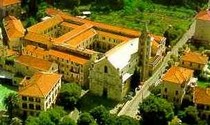Fra Angelo
Historical note
BROTHER ANGELO FROM ALBENGA
Today we begin to talk about Brother Angelo from Albenga, born Giovan Battista de Ceriariis from Albenga, who was actually born in the hamlet of Sàlea in 1487/8.
He wore the Olivetan habit on 21 March 1502 (at the age of 14/15), to make his religious profession in Finalpia in 1503.
The Olivetan congregation was founded by San Bernardo Tolomei (1272-1348), born Giovanni, belonging to a noble Sienese family.
The mother house of the new monastic family was the Abbey of Monte Oliveto Maggiore, also in the Sienese area.
To prevent the government of the abbey from falling into the hands of personalities extraneous to the monastic community, interested only in plundering the assets of the monastery, the duration of the abbey office was limited to a single year ((the political organization of the Sienese Republic was taken as a model, where the magistracies were annual).
Under Tolomei's government, Olivetan monasticism consolidated and spread.
The dress of the Olivetans consisted of a tunic, a scapular with a hood, a belt, a cowl and a white cloak, as a sign of devotion to the Virgin.
(We see here on the side the portrait of an Olivetan monk (16th century), attributed to Battista Franco).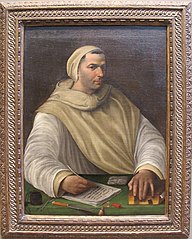

Our brother Angelo to prepare for the priesthood reached Monte Oliveto Maggiore in 1507.
When he arrived there in 1507, the church proudly displayed a vast choir with inlays and carvings completed approximately between 1502 and 1505 by the brother Giovanni from Verona assisted in the undertaking by the oblate Antonio from Venezia. The sight of the series of perspective inlays by Giovanni from Verona must have been decisive in directing brother Angelo's figurative taste towards a language of classical origin.
Brother Angelo was ordained to the priesthood on 21 March 1511.
Today (2023) we see in the background of the wall behind the main altar the exhibition of the organ, which is a remake of the original wooden frame that contained the polyptych of the original painting of the Madonna of Pia. The retreat of the monumental eighteenth-century marble main altar, completed by 1980, gave more space to the assembly of the faithful in the church hall, but took away, in addition to the wooden platform on which the organist and singers stood, a clearance space of a few metres.
This frame was part of an air series of wooden furnishings, partly surviving, partly lost or dispersed, commissioned by the Olivetan monk Brother Angelo from Albenga, while he was, between 1530 and 1532, Abbot General of the Congregation of the Olivetan Benedictines.
As can be seen from a memorial written by himself in the first person and in the vernacular, he then had the opportunity to follow the progress of the construction on site after having received the appointment of prior of the Finalese monastery for the third time, from 1532 to 1534, and, finally, as abbot in 1535.
Fra' Angelo's commitment to defining the Renaissance facies of our monastery is due to the strong bond that bound him to this community, in which he had worn the Olivetan habit, to make his religious profession there a year later.
His first assignment as prior in Finalpia, which lasted from May 1518 to May 1523, (when he moved on to direct the Roman monastery of Santa Maria Nuova) was dedicated to the construction works of the ground floor of the north wing of the Olivetan monastery of Finalpia and is marked by some dates.
The access portal to the refectory, in the north-east wing near the second cloister, dated 7 September 1519,the access portal to the refectory, in the north-east wing at the second cloister.
1521 appears on a corbel of the vault covering the opposite room, now used as a breakfast room. The year 1522 is engraved in Arabic numerals on the intrados of the double-exposed portal - again in pink Finale stone - which marks the passage between the second and first cloister. Since then, however, Fra' Angelo wanted to furnish the church with 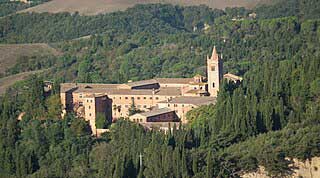 elegant and modern wooden liturgical furnishings, according to the model of the Archicenobium of Monte Oliveto Maggiore, where he had spent the years preceding his priestly ordination. (We see the Archicenobium on the left) When he arrived there in 1507, the church displayed a vast choir with inlays and carvings made approximately between 1502 and 1505 by his colleague Brother Giovanni from Verona assisted in the undertaking by the oblate Antonio from Venezia. The same workshop had created, in 1502, the cupboard for the choir books in inlay and, in carving, a large candelabra for the Easter candle.
elegant and modern wooden liturgical furnishings, according to the model of the Archicenobium of Monte Oliveto Maggiore, where he had spent the years preceding his priestly ordination. (We see the Archicenobium on the left) When he arrived there in 1507, the church displayed a vast choir with inlays and carvings made approximately between 1502 and 1505 by his colleague Brother Giovanni from Verona assisted in the undertaking by the oblate Antonio from Venezia. The same workshop had created, in 1502, the cupboard for the choir books in inlay and, in carving, a large candelabra for the Easter candle.
 elegant and modern wooden liturgical furnishings, according to the model of the Archicenobium of Monte Oliveto Maggiore, where he had spent the years preceding his priestly ordination. (We see the Archicenobium on the left) When he arrived there in 1507, the church displayed a vast choir with inlays and carvings made approximately between 1502 and 1505 by his colleague Brother Giovanni from Verona assisted in the undertaking by the oblate Antonio from Venezia. The same workshop had created, in 1502, the cupboard for the choir books in inlay and, in carving, a large candelabra for the Easter candle.
elegant and modern wooden liturgical furnishings, according to the model of the Archicenobium of Monte Oliveto Maggiore, where he had spent the years preceding his priestly ordination. (We see the Archicenobium on the left) When he arrived there in 1507, the church displayed a vast choir with inlays and carvings made approximately between 1502 and 1505 by his colleague Brother Giovanni from Verona assisted in the undertaking by the oblate Antonio from Venezia. The same workshop had created, in 1502, the cupboard for the choir books in inlay and, in carving, a large candelabra for the Easter candle.The sight of the row of perspective inlays by Giovanni from Verona must have been decisive in directing Brother Angelo's figurative taste towards a language of classical origin.
And who knows if he too, like his other colleagues did not consider with some perplexity the large cycle of frescoes that was taking shape by Sodoma between 1505 and 1508 on the large cloister walls of the Archicenobium.
On the impression of that first and long stay in Monte Oliveto, Brother Angelo, having received the appointment as prior of Santa Maria "de Valle Pia", set about finding the wood necessary for the construction of the furnishings: he bought it in Northern Tuscany (in Massa and Pietrasanta), in Provence and procured them in Pallare, in the upper Val Bormida, and in the Langhe, in the wooded estate of San Benedetto Belbo, property of the Olivetans of Finalpia since 1491. The workshop proposed to transform that wood into furniture could have been, since then, that of Brother Giovanni from Verona in exclusive service, with golden exceptions, of the Olivetan Congregation.
Brother Angelo's ambitious program was realised much later: the continuation of the construction of the monastery had taken precedence over the rest.
He himself took on the task of completing an undertaking that had perhaps already been started several years earlier thanks to the interest of Carlo Domenico Del Carretto, brother of Galeotto II - promoter of the Olivetan settlement of Finalpia - and of Alfonso I, with whom he had disputed the succession to the government of the Marquisate of Finale, to get the better of him in the year 1500. An inscription placed under a lost portrait of Carlo Domenico, exhibited in the convent of Santa Caterina in Finalborgo, obviously celebrating his brilliant ecclesiastical career, referred in particular to the attention paid in equal measure to the two religious settlements of Finalborgo and Finalpia: «conventum et ecclesiam Sancte Caterinae fratrum ordinis predicatorum in opidoFinarii ac ecclesiam Sancte Mariae et conventum fratrum ordini Sancti Benedicti instauravit et pulcherimis buildings amplíficavit ac vestibus sericís auro etargento intextis ac campibus aureís et argenteis divino cultu accomodatis exomavit». (He established the assembly and the church of St. Catherine of the brothers of the order of preachers in the town of Finari, and the church of St. Mary and the assembly of the brothers of the order of St. Benedict, and he enlarged them with beautiful buildings, and he decorated them with silk garments woven with gold and silver, and with gold and silver vessels arranged for divine worship. The prelate, therefore, also set up («instauravit») and increased («amplificavit») the monastery of Finalpia and, as proof of this, the description of the abbey church of 1705 indicated in the counter-façade of the church, just under the roof and in line with the entrance, the presence of a «large Carretto weapon with a cardinal's hat», certainly to be attributed to Carlo Domenico Del Carretto, awarded the cardinal's galero by Julius II in 1505.
On the initiative of the cardinal, therefore, by 1514, the date of his death, the so-called "church of men" was built, which extended the oldest building of Santa Maria.
Brother Angelo arrived in Finalpia in his early thirties and it can be said that here he developed his skills as leader of a monastic community; he shared the ambitions of the lords of Finale who also wanted to strengthen this religious center a short distance from the capital of the Marquisate, in the direction of Noli and Genoa.
The Finale context, from a cultural point of view, was anything but backward, indeed it was now aware of the classicist 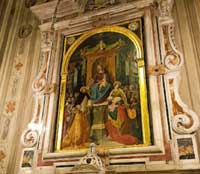 culture well assimilated by Brother Angelo in Monte Oliveto Maggiore.
culture well assimilated by Brother Angelo in Monte Oliveto Maggiore.
 culture well assimilated by Brother Angelo in Monte Oliveto Maggiore.
culture well assimilated by Brother Angelo in Monte Oliveto Maggiore.A harmony of artistic taste had to be established between the marquis family and the Olivetan prior: from Tuscany, during the 1920s, a Madonna of the rosary destined for Saint Catherine of Finalborgo (now in San Biagio), whose attribution to the San Gimignano painter Vincenzo Tamagni, Raphael's collaborator on the construction site of the Vatican Loggias, must be accepted. And one wonders whether the intermediary could not have been Brother Angelo himself, who, as Abbot General, obtained from Sodoma's pupil, just over twenty years old, Bartomeo Neroni known as Riccio, that the miniated initials of the choral books destined for Finalpia appeared to be a sort of anthology of the most recently published Sienese painting.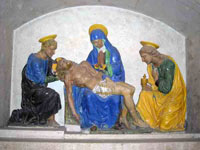

At the same time, in the monastery of Finalpia there was very little left if another twenty-year-old painter, this time from Arezzo, Giorgio Vasari, did not arrive in person, or with some of his works - destined for a very bright future as an artist, historiographer and courtier of the Grand Duke of Tuscany - who came into contact with Brother Angelo. In the face of various cultural curiosities, which embrace different declinations of the "Modern Manner", he always remains the most suspect in the commission of the three glazed terracottas distributed between the sacristy and the monastery.
The altarpiece we are dealing with and the choir stalls now recomposed in the chapter survive on site. The lectern was sold to Elia Volpi and is missing; the rest no longer exists.
The date of the consecration of the main altar of the church and the ground floor of the monastery, which took place on 5 June 1533 with a ceremony presided over by the bishop of Sebaste, Domenico Grimaldi «de la Crovara», constitutes the point for counting backwards the «two years and less" necessary to create all the cabinet-making listed by Brother Angelo.
The start of the enterprise must have taken place at least at the end of 1530 and this raises some problems regarding the destination of Antonio from Venezia who, according to the Olivetan Familiarum tabulae, in 1530-1531 and in 1531-1532 should have resided in the monastery of Sant 'Elena in his hometown.
The Provost was assigned to Finalpia together with Brother Angelo only from May 1532 and remained there until 1534. The periods of stay established by the General Chapter, especially in the case of an artist monk, could be subject to variations. Brother Antonio left the monastery of Venice to go to Finalpia, where the woods that had been seasoning there for several years were waiting for him, ready to be worked. The painter to whom Brother Angelo entrusted the lost pictorial decoration of the presbytery part of the church of Finalpia also came from Venice, Vincenzo Petronio, who finished the work, like Brother Antonio, in 1533 and was paid with the funds allocated by Bishop Paolo Del Carretto.
For the record it should be reported that, having furnished the presbytery of the church, whose floor was then covered with marble and ceramic laggioni by December 1534, Brother Angelo dedicated himself to the sacristy. With a contribution of twenty-five scudi from Paolo del Carretto, in 1534 the construction of the "spalera", i.e. the wardrobe for the sacred vestments, began, again entrusted to Brother Antonio who made use of the collaboration of Brother Martino from Treviglio . As has already been reported, the piece of furniture still exists, albeit remodelled and damaged in some parts.
The main altar in the context of the ancient church of Santa Maria: an open problem. The object that can be admired today is, as we said, completely out of context: there is only fragmentary information about its original structure. Brother Angelo reports that in 1534, once the consecration had taken place, he had incurred the expenses for the construction of the floor of the main altar, in black and white marble, raised above that of the nave by some steps, the front of which was to be decorated with majolica laggioni purchased on the occasion.
The decrees issued by Monsignor Nicolò Mascardi during the apostolic visit of 1585 are not helpful in providing even an approximate image of the layout of the liturgical furnishings built by Angelo from Albenga.
The series of works carried out by Brother Angelo have been reported, even if today they are mostly not verifiable due to the profound transformations carried out in the church especially in the first twenty years of the century. XVIII with the erection of the massive Ancona and the lengthening of the temple.
Much data was obtained from the autobiography written by Brother Angelo (in 16th century Italian), of which we were only able to consult some excerpts.
More information is probably available in Monte Oliveto Maggiore.
